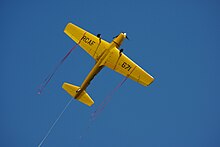
Back دي هافيلاند كندا دي إتش سي-1 تشيبمونك Arabic DHC-1 Chipmunk Danish De Havilland Canada DHC-1 German De Havilland Canada DHC-1 Chipmunk Spanish دی هاویلند کانادا دیاچسی-۱ چیپمونک Persian De Havilland Canada DHC-1 Chipmunk Finnish De Havilland Canada DHC-1 Chipmunk French דה הבילנד DHC-1 צ'יפמנק HE DHC–1 Chipmunk Hungarian De Havilland Canada DHC-1 Chipmunk ID
| DHC-1 Chipmunk | |
|---|---|

| |
| A Chipmunk with the Royal Navy historical flight | |
| Role | Trainer |
| Manufacturer | de Havilland Canada |
| First flight | 22 May 1946 |
| Introduction | 1946 |
| Retired | 1955 (Belgium) 1972 (Canada) 1996 (United Kingdom) |
| Status | In service |
| Primary users | Royal Air Force (historical) Royal Canadian Air Force (historical) Portuguese Air Force |
| Produced | 1947–1956 |
| Number built | 1,284 (including Canadian, British, and Portuguese production)[1] |


The de Havilland Canada DHC-1 Chipmunk is a tandem, two-seat, single-engined primary trainer aircraft designed and developed by Canadian aircraft manufacturer de Havilland Canada. It was developed shortly after the Second World War and sold in large numbers during the immediate post-war years, being typically employed as a replacement for the de Havilland Tiger Moth biplane.
The Chipmunk was the first postwar aviation project conducted by de Havilland Canada. It performed its maiden flight on 22 May 1946 and was introduced to operational service that same year. During the late 1940s and 1950s, the Chipmunk was procured in large numbers by military air services such as the Royal Canadian Air Force (RCAF), Royal Air Force (RAF), and several other nations' air forces, where it was often utilised as their standard primary trainer aircraft. The type was produced under licence by de Havilland in the United Kingdom, who would produce the vast majority of Chipmunks, as well as by OGMA (Oficinas Gerais de Material Aeronáutico) in Portugal.

The type was slowly phased out of service beginning in the late 1950s, although in the ab initio elementary training role, this did not happen in the Royal Air Force until 1996, when it was replaced by the Scottish Aviation Bulldog.
Many Chipmunks that had been in military use were sold to civilians, either to private owners or to companies, where they were typically used for a variety of purposes, often involving the type's excellent flying characteristics and its capability for aerobatic manoeuvres. More than 70 years after the type having first entered service, hundreds of Chipmunks remain airworthy and are in operation around the world.[1] The Portuguese Air Force still operates six Chipmunks, which serve with Esquadra 802, as of 2018.[2]
© MMXXIII Rich X Search. We shall prevail. All rights reserved. Rich X Search